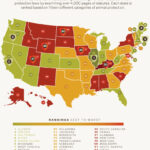The issue of animal cruelty is a pressing concern, manifesting in various forms and affecting countless animals worldwide. The FBI has developed a systematic approach to monitor and address this grave issue through the establishment of the Animal Cruelty Statistics Program. This initiative serves as a substantial resource that illuminates the sad reality of animal neglect and abuse within the United States. Understanding the scope of this initiative and the data it reveals is essential for animal advocates, policymakers, and the general public.
Historically, animal cruelty cases have often been relegated to local law enforcement agencies, resulting in a fragmented understanding of the issue. However, the FBI’s inclusion of animal cruelty as a distinct criminal category in the National Incident-Based Reporting System (NIBRS) signifies a turning point in the recognition of animal rights and the seriousness of these offenses. This article delves into the nature of the FBI’s tracking methods, the types of data collected, and the implications of this data for animal welfare initiatives.
The FBI collects data on various types of animal cruelty, which can be broadly categorized into three essential areas: neglect, intentional abuse, and animal sexual exploitation. Each of these categories encompasses a range of specific offenses that paint a comprehensive picture of the cruelty faced by animals. Neglect cases often involve inadequate food, water, shelter, or medical care, culminating in severe suffering or death. Typical examples include hoarding situations and abandonment, where animals are left to fend for themselves in deplorable conditions.
Intentional abuse, on the other hand, demonstrates a more overt disregard for the welfare of animals. This category includes physical violence, torture, and fighting. Cases such as dog fighting, where animals are forced to engage in violent encounters for human entertainment, highlight the darker aspects of human behavior. The resultant injuries range from superficial wounds to life-altering damage or death, drawing attention to societal attitudes that normalize such barbarity.
Animal sexual exploitation represents one of the most egregious forms of cruelty. While it may be less discussed in public forums, this type of abuse is crucial to monitor and address. The inclusion of this category in the FBI’s statistics underscores the array of challenges faced by law enforcement when confronting animal cruelty, as societal stigmas can often obscure the heinous nature of such acts.
The data collected by the FBI reveals alarming trends that can inform preventive measures and advocacy efforts. Often, the statistics highlight how animal cruelty tends to be a precursor to other forms of violence, including domestic abuse and child maltreatment. Research indicates a significant overlap between those who commit crimes against animals and those who perpetrate violence against people. This disturbing correlation underscores the importance of addressing animal welfare not merely as an isolated area of concern but as an integral component of broader social issues.
Furthermore, the geographic distribution of reported animal cruelty cases offers a window into regional attitudes toward animal welfare. Urban areas with high populations often experience a higher prevalence of animal neglect and abuse, potentially due to economic stresses and inadequate resources for law enforcement. Conversely, rural regions may exhibit different patterns, with the cultural significance of farming and livestock impacting the local understanding of animal treatment. Recognizing these variances can inform targeted intervention strategies to promote animal welfare more effectively across different communities.
Moreover, the FBI’s data facilitates the evaluation of the efficacy of existing laws and regulations governing animal welfare. By analyzing trends over time, advocates can ascertain whether legislative changes lead to an increase in reporting and prosecution of animal cruelty cases or if they create unintended consequences, such as increased criminalization of cultural practices. This information is invaluable for policymakers and advocacy groups working to improve legal frameworks around animal rights.
Awareness of these statistics is critical for enhancing public discourse surrounding animal cruelty. Campaigns aimed at elevating the issue can utilize FBI data to underscore the urgent need for community awareness and involvement. Education initiatives can empower individuals to recognize and report animal cruelty, fostering a culture of vigilance and compassion.
The data gathered by the FBI also aids in mobilizing resources for rescue organizations and shelters that work tirelessly to rehabilitate victims of cruelty. Understanding the prevalence of certain types of abuse can inform resource allocation, enabling organizations to better prepare for the challenges they face. Whether it’s increasing the capacity of shelters or providing specialized training for law enforcement, the statistics serve as a guiding force in the fight against animal cruelty.
In conclusion, the FBI’s initiative to track animal cruelty crimes stands as a testament to the importance of understanding and addressing this multifaceted issue. The data reveals a grim reality that is all too often overlooked and underscores the necessity for comprehensive action at various societal levels. The integration of this information into public policies, educational initiatives, and legal reforms is indispensable for advancing animal welfare. By continuing to scrutinize and amplify these statistics, activists, lawmakers, and concerned citizens can illuminate the path toward more humane treatment of all sentient beings. The dialogue surrounding animal cruelty needs to foster a compassionate society where the rights of animals are recognized and protected, transforming not only lives but also the moral fabric of our communities.










